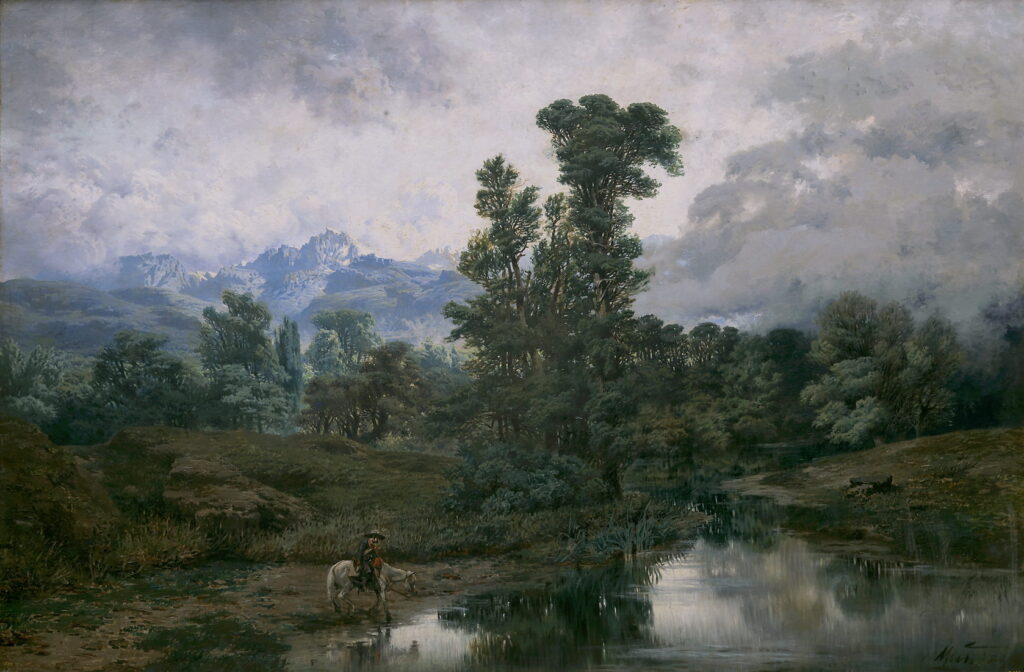Landscapes of Spain: The nineteenth century

On Christmas Eve 1734 Europe came close to losing many of its greatest paintings, when the Royal Alcázar of Madrid caught fire. At the time it housed much of the Spanish royal collection; although some were lost, many survived to form the core of the Museo Nacional del Prado, which opened to the public in November 1819. Since then a steady succession of aspiring painters have made their way to Madrid to study the works of Hieronymus Bosch, El Greco, Peter Paul Rubens, Titian, Diego Velázquez, Francisco Goya, and others in the Prado.
Although few of its masterworks depict landscapes, the Prado has drawn many landscape artists who have also taken the opportunity to paint Spanish views. This weekend I show a small selection of landscape paintings made of the interior of the country by visitors and natives.
Rosa Bonheur (1822–1899), Spanish Muleteers Crossing the Pyrenees (1857), oil on canvas, 116.8 × 200 cm, Private collection. Wikimedia Commons.
The French animalière Rosa Bonheur seems to have visited the Pyrenees, the mountain range forming the north-east border of Spain, on at least two occasions. Her Spanish Muleteers Crossing the Pyrenees from 1857 incorporates one of her most spectacular landscapes, some of which were painted in collaboration with her father. At the time mules like these were still an important means of trade over the Pyrenees, via traditional routes over passes that had been used by animals and humans for millennia.
Martín Rico y Ortega (1833–1908), View of the Village of El Escorial with the Church of Saint Barnabus (1852-58), watercolour on laid paper, 11.1 x 18.1 cm, Museo Nacional del Prado, Madrid, Spain. Wikimedia Commons.
While Martín Rico was studying at the prestigious Real Academia de Bellas Artes de San Fernando in Madrid, he painted a series of watercolour landscapes of his home town and its environs. Among them is this View of the Village of El Escorial with the Church of Saint Barnabus (1852-58). This appears to have been painted in front of the motif, and for the rest of his career, Rico was an enthusiastic painter en plein air.
Martín Rico y Ortega (1833–1908), Guadarrama Landscape (1858), oil on canvas, 69 x 100 cm, Museo Nacional del Prado, Madrid, Spain. Wikimedia Commons.
Rico progressed to oils by 1858, when he painted Guadarrama Landscape, shown at that year’s National Exhibition. This rugged area is now a national park, and is to the north-east of El Escorial. The mountains shown are the Sierra de Guadarrama. This dramatic view shows the influence of his Professor of Landscape Painting at the Academy, who was a renowned Romantic.
Martín Rico y Ortega (1833–1908), Near Azañón (1859), oil on canvas, 82 x 160.5 cm, Museo Nacional del Prado, Madrid, Spain. Wikimedia Commons.
His landscape painted Near Azañón in 1859 places a Wanderer figure in arid country in his native Spain. Unusually, this Wanderer faces the viewer rather than looking away. This is in the province of Guadalajara in central Spain.
Martín Rico y Ortega (1833–1908), Country View (1861), media and dimensions not known, Real Academia de Bellas Artes de San Fernando, Madrid, Spain. Wikimedia Commons.
Country View from 1861 is another of his landscapes from the early years of his career, before he discovered Venice and devoted his later life to painting its canals.
Antonio Muñoz Degrain (1840–1924), Landscape of El Pardo as the Fog Clears (1866), oil on canvas, 200 x 300 cm, Museo Nacional del Prado, Madrid, Spain. Wikimedia Commons.
Antonio Muñoz Degrain’s early Landscape of El Pardo as the Fog Clears from 1866 is set in El Pardo Mountain Reserve, the hunting grounds of the Spanish royal family, where one of its rangers is taking his horse to water. The mountain in the background is Guadarrama, which is surprisingly alpine and rugged. This is close to the location seen in Rico’s Guadarrama Landscape above.
Franz von Lenbach (1836–1904), The Alhambra in Granada (1868), oil on canvas, 72.1 × 91.5 cm, Sammlung Schack, Bayerische Staatsgemäldesammlungen, Munich, Germany. Wikimedia Commons.
In 1867, Franz von Lenbach and a student of his travelled from Munich to Madrid to copy the Masters there for his patron Baron Adolf von Schack. The following year, von Lenbach painted two works in Granada: The Alhambra in Granada (1868) is a magnificent sketch including the backdrop of the distant mountains, and appears to have been painted in front of the motif.
Mariano Fortuny y Marsal (1838–1874), Granada Landscape (1871), oil on canvas, 80 x 45 cm, Museu Nacional d’Art de Catalunya, Barcelona, Spain. Wikimedia Commons.
Mariano Fortuny’s Granada Landscape from 1871 is a plein air oil sketch painted when the artist was living in Granada between 1870-72.
Ferdinand Hodler (1853–1918), Landscape Near Madrid (1878), oil on canvas, 71 × 50 cm, Private collection. Wikimedia Commons.
Ferdinand Hodler travelled from Geneva in Switzerland to Madrid in 1878 to study the works of the masters there for several months. While he was there his landscapes became brighter, higher in chroma, and increasingly artistic rather than just representational, as shown in this Landscape Near Madrid (1878).
William Merritt Chase (1849-1916), Sunny Spain (1882), oil on canvas, 49.5 x 74.3 cm, Private collection. WikiArt.
When the great American landscape artist and teacher William Merritt Chase was in Europe in the summer of 1882, he painted Sunny Spain (1882).
Edmund Wodick (1816–1886), Granada (1886), oil on canvas, dimensions not known, Kulturhistorisches Museum Magdeburg, Magdeburg, Germany. Wikimedia Commons.
The German artist Edmund Ludwig Eduard Wodick painted this view of Granada in 1886; shortly afterwards he developed pneumonia and died at the age of 69. He located himself just outside the city walls, looking across at the Alhambra and its towers, down towards the lush green plain and the snow-capped peaks in the far distance.
Hernandez Miguel Vico (1850-1933), Alhambra and Cuesta de los Chinos (date not known), further details not known. Wikimedia Commons.
This is a contrasting view of the Alhambra painted by Hernandez Miguel Vico, a local artist. The Cuesta de los Chinos is the steep road seen here, and forms one of the pedestrian accesses to the palace.



